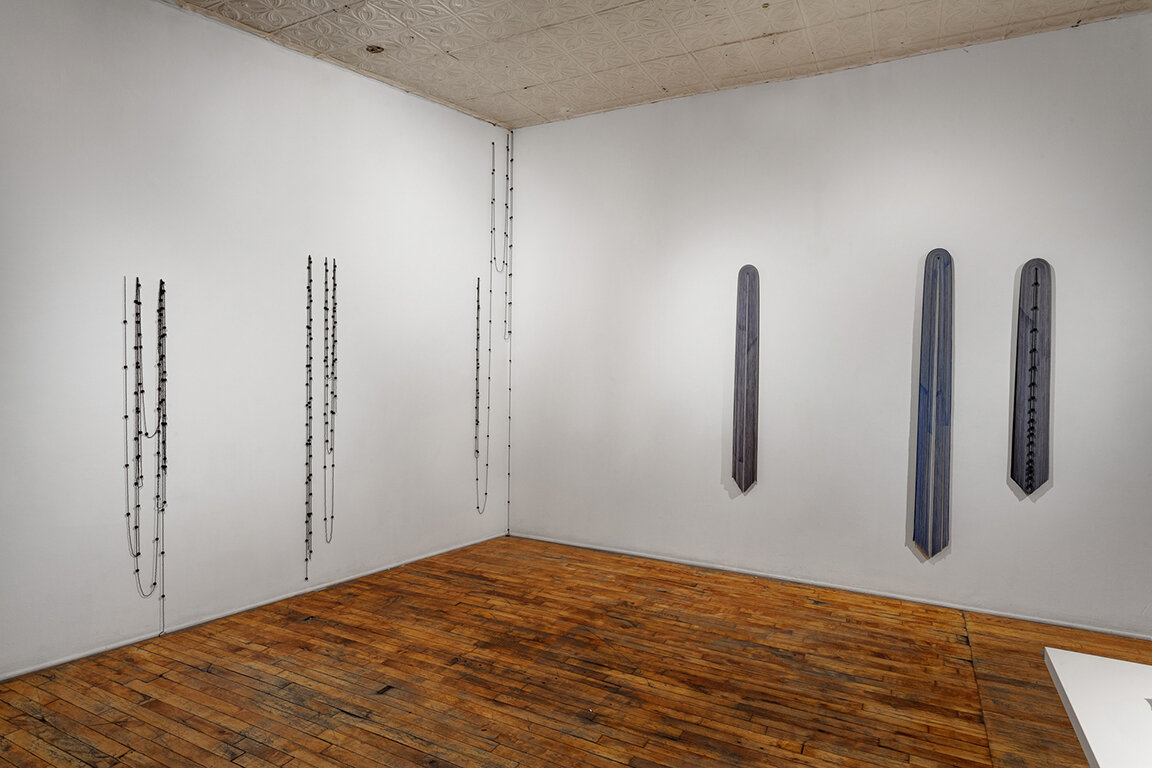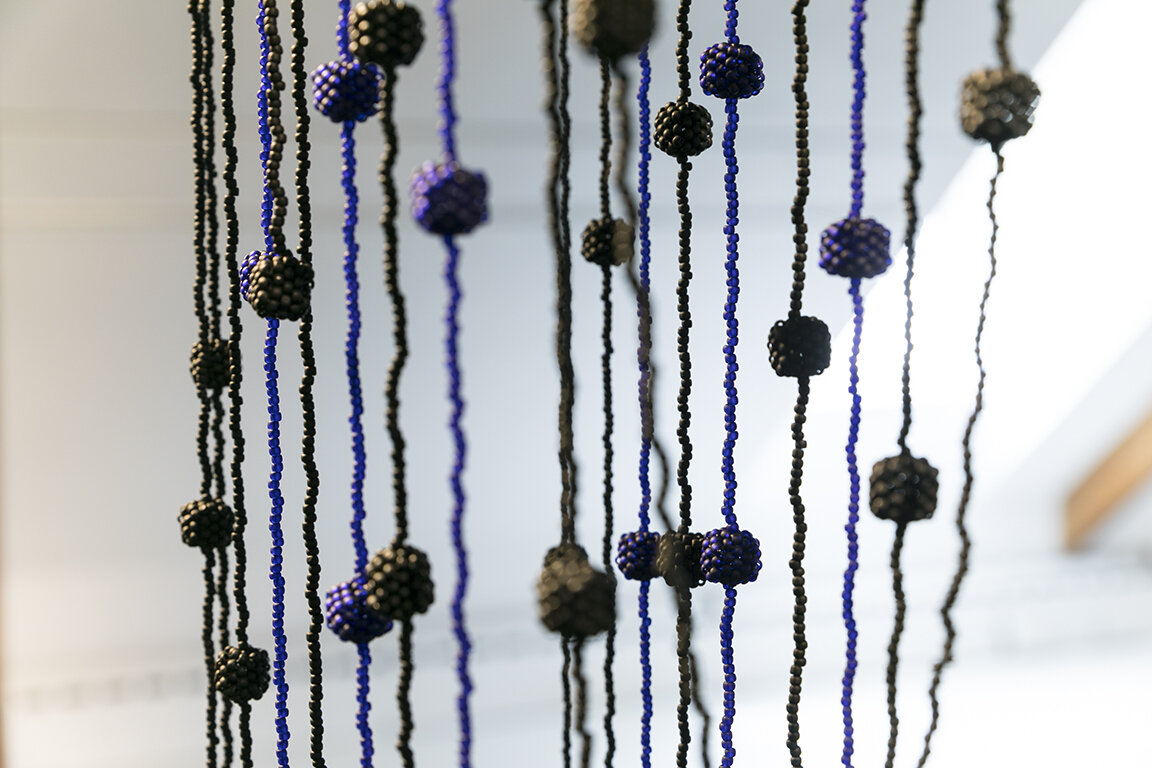Surabhi Ghosh is an artist based in Montreal, Quebec, where she is also Associate Professor of Fibres & Material Practices in the Department of Studio Arts at Concordia University. She uses textiles, patterning, and site-responsive installations to materialize contradictory narratives based in her own experiences, while analyzing the relations between materials, objects, and their contested cultural meanings. In her recent work, she investigates the transmission of culture and nationalist ideology between her three “homelands” of India, the United States, and Canada.
For more information, please see: surabhighosh.com, and on Instagram @beebeeghosh.
Surabhi Ghosh, Garlanding & Guise, 2017, upholstery vinyl, screws, ink, tape, 159 x 109 x 40 in. Photo: Joel Tsui. Image courtesy of the artist.
First, and most importantly, how are you doing? How are you navigating the highs and lows? Where are you physically?
I’m doing OK, lots of ups and downs! It’s been tricky to find self-discipline and create a new routine. Mostly I feel incredibly fortunate to have a secure income and home, and I’m appreciating every little thing more than ever before.
I’m in Tiohtià:ke / Mooniyang / Montréal / Montreal, where I’ve lived since 2014. I’m lucky to have a studio in my apartment—it’s a bit small, but at the moment, I’m so glad my commute to the studio is just a flight of stairs.
Surabhi Ghosh, Garlanding & Guise (detail), 2017, upholstery vinyl, screws, ink, tape, 159 x 109 x 40 in. Photo: Joel Tsui. Image courtesy of the artist.
It's my experience that most artists engage with some level of self-isolation in their day to day art practice. Has this been your experience? And if so, have you found these innate rhythms to be helpful during this larger, world-wide experience of isolation?
Yes, I have always worked most productively when I’m alone in the studio. A lot of my time is spent working with groups of people, whether colleagues or students, so I’ve always tried to carve out and protect my studio time, which is also alone time. I’ve had more time recently, but the mental space has been pretty hard to find.
Before the pandemic, I had also been loving weekly studio sessions with three of my favorite people, also my studio assistants, all of whom are very skilled artists: Gisèle Suzor-Morin, Amélie Bélanger, and Elena Hoh. As we wrapped up our last meeting on March 12, I worried we might not be able to meet for a few weeks. As the weeks turned into months, we ended up mailing things back and forth, tracking our inventory online, checking in on the phone … and thanks to this incredible team, two major projects were completed over the past 6 months. Well, except for the actual installations.
Two-page spread from publication “Garlanding & Guise” (2019). Book design and altered comic book panels by Surabhi Ghosh. Imagery sourced from Draupadi,Amar Chitra Katha, no. 542. Image courtesy of the artist.
Surabhi Ghosh, Garlanding #3, 2019, acrylic gouache on vellum, 14 x 17 inches. From the ongoing Garlandingseries. Image courtesy of the artist.
It would be great if you could briefly talk us through your practice. Understanding it is integral to appreciating the multivalence of your work.
Yes, here’s to multivalence! My practice is rooted in fibres; another term could be something like material mark-making. Some days I think of myself as a storyteller, working in a long lineage of artists and ancestors. I prioritize using familiar and accessible tools, like needle and thread or a pair of scissors; I don’t want viewers to get too stuck on the “how” questions instead of the “whys” and “what ifs.” I also work with the book format, and recently I’ve been writing more too.
My overarching interests are in: (1) narratives (the ones told or transmitted to me and the ones I tell with my work), and (2) patterning (the result of a series of repetitive actions that is then transmitted as a message). Even more broadly, I could describe it as a curiosity about language. Currently I’m driven by a motivating series of questions about repetitive, recurring, or cyclical narratives. Who is allowed to tell what stories and to whom? What stories get told and retold over time and distance—and how are they transmitted via material-objects? Why are some stories more impactful or more valued than others? What is the intent of the storyteller? How can and does a listener commit to active (versus passive) listening? How does the fictionalizing or mythologizing of events serve and/or hurt the audience? Etc, etc… one question inevitably leads to another.
2018 concept map, used to organize research and thought process, graphic design by Sujata, for publication titled “Garlanding & Guise” (2019), published by Surabhi Ghosh with funding from the Canada Council for the Arts. Image courtesy of the artist.
Surabhi Ghosh, Garlanding & Guise (detail), 2017, upholstery vinyl, screws, ink, tape, 159 x 109 x 40 in. Photo: Joel Tsui. Image courtesy of the artist.
Has any of your imagery shifted in a reflection to what's currently happening? And why, or why not?
No, not so far, but I may have found new layers of potential meaning in my imagery and forms. I hope that viewers may also find new resonance in the work too. My work may appear to be quite controlled, mathematical, and rational, but it is also based in raw emotional responses—so I wonder if audience interpretations will shift at all. For example, some people might be thinking about their relationship to measurements, numbers, and statistical data in a new way, as they concurrently grapple with intense feelings of worry, grief, anger, disorientation—will this experience affect how they perceive the incremental patterns and units + the grief and anger in my work?
Since 2016, I’ve focused on recurring uses of language or motif during periods of increased nationalist rhetoric or spectacle, like right now. So, for example, the forms I’m referencing in my work (garlands, necklaces, arched gateways, doorways, toran) reflect my ongoing preoccupation with the language that is wielded subtly (or not) to unite and divide the body politic. Over time, through repetitive reinforcement, fears become “our values,” a burden that is carried in and on “our” bodies and passed from one generation to the next. But I seek potentials for breaking cycles, without disrespecting the past.
My “Garlanding” pieces explore many themes, but central is a narrative of living in the face of tragedy. My title Garlanding & Guise refers to the coopting of cultural signifiers, like the Hindu flower garland, for political spectacles in (Hindu supremacist) India and (white supremacist) North America—in other words, the ideological manipulation of the political body, via the perversion of something with deep and layered meaning (spiritual, familial, intimate, embodied) into a visual prop for nationalist performances, enabling yet another resurgence of racism, xenophobia, classism, ableism, misogyny. So no, nothing has changed in my work, but potentially viewers will be more attuned to the sense of urgency the work already had for me.
Mirabai endpaper design for publication titled “Garlanding & Guise” (2019). Pattern design and altered imagery by Surabhi Ghosh. Image sourced fromMirabai, Amar Chitra Katha, no. 36. Image courtesy of the artist.
Surabhi Ghosh, Layering, 2019, upholstery vinyl, ink, screws, tape, glass beads, thread, 66 x 72 x 1 inches. Photo: Robert Chase Heishman. Image courtesy of the artist.
Surabhi Ghosh, Layering (details), 2019, upholstery vinyl, ink, screws, tape, glass beads, thread, 66 x 72 x 1 in. Photo: DPM. Image courtesy of the artist.
Are you thinking differently? Coping differently? Inspired differently?
As I’ve been working over the past months, I’ve reflected on my past, current, and future work, both as an artist and a teacher. I’m not yet sure where I’m going next, but I’m definitely feeling the urge to rearticulate some of my driving principles.
It’s really important for me to think about art-making as a highly deliberate act, a series of decisions, and a process of call-and-response within the time and space I inhabit—not passively but actively! Every stitch to add a single seed bead into a sculpture is a deliberate action, a visual/material assertion I transmit into the cultural realm. I use formal language to inspire curiosity, which potentially leads to critical thinking. Mirroring what happens during my creation process, I aim to project questions and critical speculation rather than definitive statements. Does your interpretation shift depending on how you move your body around the bounded space of a gallery? What does it mean to “look at” versus “look up at” or “look down at” something? I think talking about subjectivity, positionality, visual literacy, or just critical analysis in general is crucial right now.
I’m in the last phase of finishing a new project and preparing to install it at Montreal’s Museum of Contemporary Art in a very thoughtfully curated group exhibition. This new work-in-progress has definitely taken me in a new direction, which I can’t fully understand until it’s actually up on the wall, but I’m excited to follow this trajectory in the next months. My title is Taken in, taking on; hopefully viewers can start their interpretations by spending time with the piece while wondering: what does it mean to be “taken in” by something vs. by someone, and what does it mean to “take on” something vs. someone?
Surabhi Ghosh, (Left) What’s mine is yours, 2019, glass beads, thread, steel pins, variable dimensions; (Right )Layering, 2019, upholstery vinyl, ink, screws, tape, glass beads, thread. Installation view, Heaven Gallery, Chicago, IL.Photo: Robert Chase Heishman. Image courtesy of the artist.
Surabhi Ghosh, Dispossess (detail), 2019, glass beads, thread, variable dimensions. Installation view at Stewart Hall Art Gallery, Pointe-Claire, QC, Canada. Photo: DPM. Image courtesy of the artist.
What research or writing are you doing that you find compelling? Are you reading anything?
My primary form of research is making art, and I find new potentials every day. I’m finishing some beaded pieces and drawing a lot these days.
Just before the pandemic, I wrote a sort-of poem for Anne Wilson’s new publication project,which was made as a companion piece to her recentsolo exhibition, Anne Wilson: If We Asked about the Sky, at Rhona Hoffman Gallery in Chicago. Writing that piece after a generative back-and-forth process with Anne was really meaningful for me, and I keep going back to it, which means that writing it was research for something else.
And yes, I’m reading far too many things! Here are some examples from my current pile:
Work: The Last 1,000 Years(2018), by Andrea Komlosy.
The Intimacies of Four Continents(2015), by Lisa Lowe.
The Great Indian Novel(1989), by Shashi Tharoor.
Poetics of Relation(1990/1997), by Édouard Glissant.
Metaphors We Live By(1980), by George Lakoff and Mark Johnson, in combination with Metaphor in Culture: Universality and Variation(2005), by Zoltán Kövecses.
The Racial Contract(1997), by Charles W. Mills (thanks to Adam Serwer’s essay in The Atlantic, “The Coronavirus Was an Emergency Until Trump Found Out Who Was Dying”).
A Place at the Multicultural Table: The Development of an American Hinduism(2007), by Prema Kurien.
Surabhi Ghosh, What’s mine is yours, 2019, glass beads, thread, steel pins. Installation view at Heaven Gallery, Chicago, IL. Photo: Robert Chase Heishman. Image courtesy of the artist.
What is bringing you solace, or even joy, in this moment?
In my practice? Imbibing the work of POC artists and thinkers in all forms: art, theory, journalism, TV, film, music, podcasts, videos, and even social media.
Or in my home life? My partner and our daily conversations and debates. My kitty. The terrace on our roof. The recently repaired air conditioner. Buying local and eating summertime produce. The blockprinted Gujarati textiles that we use throughout the apartment, clashing colors and patterns in all their glory! Working on my Canadian citizenship application.
Studio panorama from summer 2019. Image courtesy of the artist.













